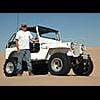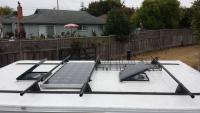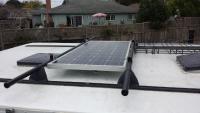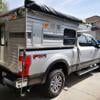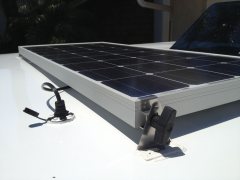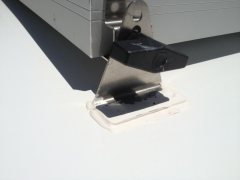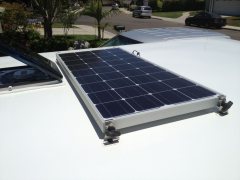Williak,
Thanks for posting the info on mounting your Solar panel. I also bought two of the Grape Solar units from Costco. We have 10' tracks on the Keystone and what you have done is very close to what I was planning to do.
I got latched up trying to devise a pivoting mount (described earlier in the post) and have mostly decided to just hard mount flat due to reliability concerns about a pivoting mount. I like your use of the Aluminum "L" material to keep the top of the panel below the bottom of the Yakima towers so we can still carry our Kayaks (or other items).
I also planned to mount the second solar panel in a slide out tray on the bottom of the cabover bed compartment. I look forward to seeing those details since I have not yet come up with a mount design there. Also I am still trying to decide on an MPT controller.
I do not know what diameter fasteners you used but you want to be sure they are large enough to handle the dynamic loads (particularly in high winds and during any off pavement travel). You also want to be sure the thickness of the Aluminum "L" allows for adequate thread engagement.
The following is based on assumption that nuts are not used and that the fasteners are threaded in to the Aluminum "L" material to minimize chance of nuts backng off the fasteners as well as fastener end (and nut) impacting the roof on bumpy roads.
Comment on fasteners I found on the web:
"As a general rule, a bolt should engage a
distance greater than or equal to its outer diameter. The number of threads engaged can then be calculated from the number of threads per inch on the bolt. So if you are using a
1/4-20 bolt, meaning it has 1/4" diameter and 20 threads per inch, you should engage the bolt 1/4" into the hole, or 5 threads. (20 threads/inch x 1/4 inches). Alternatively a #10 fastener has 24 threads per inch and you would need about 3/16" thread engagement.
Why: The shear stress on the threads will be equal to the tensile stress in the shank of the bolt. This means that once you thread the bolt in a distance greater than its diameter, the shank itself will fail before the threads shear off the bolt under tensile load.
Sources: Design of Machinery class at Purdue University, page 10 of the following MIT article:
http://web.mit.edu/2.75/resources/FUNdaMENTALs%20Book%20pdf/FUNdaMENTALs%20Topic%206.PDF"
I work in Aerospace (Optical Systems Engineer for Spaceborne Weather Sensors) and I checked with a Mechanical Engineer colleague. He confirmed the rule of thumb of engaging the fastener into material at least as thick as the fastener outer diameter. He said that 1/4-20 fasteners are far stronger than needed but since the operational environment will have unknown dynamic loads he advised sticking with #10 or 1/4" fasteners.
The bottom line is that if the fasteners are threaded into the Aluminum "L" material the thickness of the Aluminum "L" probably should be at least 3/16" thick. Another consideration for making the "L" material thicker is that you want the mounting to be stiff and not flex or allow twisting. Flexing and/or twisting can result in damage to the Solar Panel as well as the camper roof (from impacts). I have not yet looked into the minimum "L" thickness relative to twisting and flexing over the span between the Yakima tracks.
In any event (nuts or not) all fasteners probably should be #10 or larger. (if you are not already using lock washers or equivalent I strongly recommend adding them).
BTW: A technique we use on our instruments for Space is to "stake bond" fasteners. We apply a thin line of epoxy across the head of the fasteners to keep them from backing out during the dynamic loads from launch (we almost always use internal threads and don't use nuts unless they are captured).
Regards,
Craig
Edited by ckent323, 03 July 2013 - 04:43 PM.




